

2MASS
Large Galaxy Atlas
-
T.H. Jarrett
S. Van Dyk
Gene Kopan
T. Chester
June, 2001
Overview

The 2MASS Extended Source Catalog (XSC) will include all resolved galaxies, regardless of their size, but will not accurately record the integrated flux for the largest galaxies due to their proximity to a "scan" edge. A typical 2MASS survey scan is 8.5 arcmin X 6 degrees, with 10% overlap between scans. Galaxies that are smaller than the overlap, D~50 arcsec, are guaranteed to be fully sampled in at least one survey scan. Larger galaxies may be truncated based on their proximity to a scan edge. Therefore we are constructing an atlas of large galaxies made from "pieces" of adjoining scans. (see for example the detailed construction of NGC 2903.) The atlas will consist of galaxies ranging in size from 2 to 30 arcmin, with a typical resolution of ~3 arcsec (w/ 1 arcsec pixels) in the 2MASS IR bands (J, H, Ks). The completed atlas provides the aggregate flux for each galaxy and a detailed view of the infrared morphology. At the completion of the 2MASS survey, the atlas will be fully available to the public and can be accessed through the NASA Extragalactic Database (NED).
-
Nearby galaxies represent a unique laboratory set for detailed study of the largest objects in the Universe. The Atlas provides the necessary sensitivity and angular resolution to examine the diverse stellar populations, large-scale structures such as spirals, bulges, warps and bars, star formation regions and evolution of galaxies. This image atlas represents the first uniform, all sky, view of galaxies as seen in the near-infraredła wavelength window that is most sensitive to the dominant mass component of galaxies.
The Large Galaxy Atlas will represent a valuable asset to the professional and amateur astronomical communities. The near-infrared forms a natural, complementary, bridge between the well-studied optical wavelengths (e.g., POSS and SDSS) and the longer (e.g., IRAS, ISO, NVSS, FIRST) wavelengths. The near-infrared is most sensitive to the older stellar populationsłthe dominant mass component in most galaxies. Hence, the Large Galaxy Atlas is an ideal data set to combine with imaging data at other wavelengths. It provides a clear contrast between the underlying mass component and, for example, star formation regions as seen in the optical or mid-infrared bands. In addition, the atlas will function as an astrometric "finding" chart/map for both professionals and amateurs searching for supernovae in galaxies.
Necessity
- Click
here for the poster section.
Background Removal
- Click
here for the poster section.
- Click here for a detailed look at the background removal and final image construction.
3-Color Combination
- Click
here for the poster section.
Photometry and Application
- Click
here for the poster section.
Gallery
- M51ab: The Whirlpool Galaxy (M51) as seen in the three 2MASS
near-infrared bands. The
Whirlpool, and its small companion galaxy, are 33 million light years
from the Sun and are located within the Canes Venatici
(CVn) constellation. The image was re-constructed from pieces of the
2MASS image data set. The field is view is 12 arcmin. The angular resolution
is ~3 arcsec, corresponding to a physical size of 500 light years for
resolved structure in M51. Click
here for a J-band (1.2 micron) image.
- M101
- NGC 1068
- NGC 6946
- NGC 1313
- Centaurus A
- IC 10
- NGC 891
- Maffei 2
- M87
- VV 219
- NGC 1097
- NGC 2903
Related Information:
-
Infrared Galaxy Morphology, Jarrett, T.H., 2000, PASP, 112, 1008.
As part of NASA's Origins Program, 2MASS is funded by NASA's Office of Space Science and the National Science Foundation. Results from 2MASS will benefit future Origins missions, including the Space Infrared Telescope Facility (SIRTF) and the Next Generation Space Telescope (NGSS). JPL manages the program for NASA's Office of Space Science, Washington, DC. JPL and IPAC are a division of the California Institute of Technology, Pasadena, CA.